Related Research Articles

Reynoutria japonica, synonyms Fallopia japonica and Polygonum cuspidatum, is a species of herbaceous perennial plant in the knotweed and buckwheat family Polygonaceae. Common names include Japanese knotweed and Asian knotweed. It is native to East Asia in Japan, China and Korea. In North America and Europe, the species has successfully established itself in numerous habitats, and is classified as a pest and invasive species in several countries. The plant is popular with beekeepers, and its young stems are edible, making it an increasingly popular foraged vegetable with a flavour described as lemony rhubarb.

An invasive species is an introduced species to an environment that becomes overpopulated and harms its new environment. Invasive species adversely affect habitats and bioregions, causing ecological, environmental, and/or economic damage. The term can also be used for native species that become harmful to their native environment after human alterations to its food web. Since the 20th century, invasive species have become a serious economic, social, and environmental threat worldwide.

Ecological succession is the process of change in the species that make up an ecological community over time.
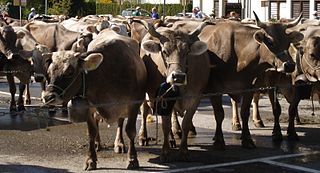
An introduced species, alien species, exotic species, adventive species, immigrant species, foreign species, non-indigenous species, or non-native species is a species living outside its native distributional range, but which has arrived there by human activity, directly or indirectly, and either deliberately or accidentally. Non-native species can have various effects on the local ecosystem. Introduced species that become established and spread beyond the place of introduction are considered naturalized. The process of human-caused introduction is distinguished from biological colonization, in which species spread to new areas through "natural" (non-human) means such as storms and rafting. The Latin expression neobiota captures the characteristic that these species are new biota to their environment in terms of established biological network relationships. Neobiota can further be divided into neozoa and neophyta (plants).
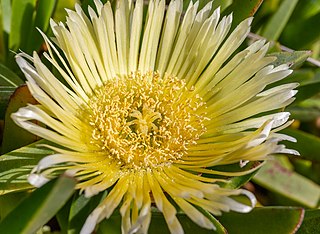
Carpobrotus edulis is a ground-creeping plant with succulent leaves in the genus Carpobrotus, native to South Africa. Its common names include hottentot-fig, sour fig, ice plant or highway ice plant.
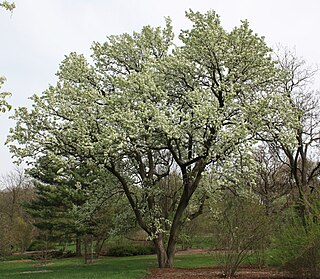
Pyrus calleryana, also known as the Callery pear or Bradford pear, is a species of pear tree native to China and Vietnam, in the family Rosaceae. It is most commonly known for its cultivar 'Bradford' and its offensive odor, widely planted throughout the United States and increasingly regarded as an invasive species.

A detection dog or sniffer dog is a dog that is trained to use its senses to detect substances such as explosives, illegal drugs, wildlife scat, currency, blood, and contraband electronics such as illicit mobile phones. The sense most used by detection dogs is smell. Hunting dogs that search for game, and search and rescue dogs that work to find missing humans are generally not considered detection dogs but fit instead under their own categories. There is some overlap, as in the case of cadaver dogs, trained to search for human remains.
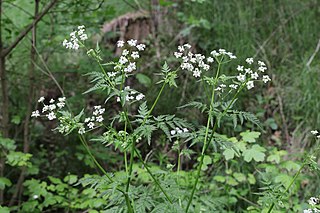
Anthriscus sylvestris, known as cow parsley, wild chervil, wild beaked parsley, Queen Anne's lace or keck, is a herbaceous biennial or short-lived perennial plant in the family Apiaceae (Umbelliferae), genus Anthriscus. It is also sometimes called mother-die, a name that is also applied to the common hawthorn. It is native to Europe, western Asia and northwestern Africa. It is related to other diverse members of Apiaceae, such as parsley, carrot, hemlock and hogweed. It is often confused with Daucus carota, another member of the Apiaceae also known as "Queen Anne's lace" or "wild carrot".

Functional ecology is a branch of ecology that focuses on the roles, or functions, that species play in the community or ecosystem in which they occur. In this approach, physiological, anatomical, and life history characteristics of the species are emphasized. The term "function" is used to emphasize certain physiological processes rather than discrete properties, describe an organism's role in a trophic system, or illustrate the effects of natural selective processes on an organism. This sub-discipline of ecology represents the crossroads between ecological patterns and the processes and mechanisms that underlie them.

Aegilops triuncialis, or barbed goatgrass, is a grass species of the family Poaceae. It is a winter annual native to many areas in Eastern and Mediterranean Europe and Western Asia. It is considered an introduced, invasive species in North America, mainly in the Western coast of the United States. In its native lands, the grass thrives in mainly rocky, serpentine soil, but also does well in grasslands and ruderal/disturbed ground as well as oak woodlands.

Setosphaeria rostrata is a heat tolerant fungus with an asexual reproductive form (anamorph) known as Exserohilum rostratum. This fungus is a common plant pathogen, causing leaf spots as well as crown rot and root rot in grasses. It is also found in soils and on textiles in subtropical and tropical regions. Exserohilum rostratum is one of the 35 Exserohilum species implicated uncommonly as opportunistic pathogens of humans where it is an etiologic agent of sinusitis, keratitis, skin lesions and an often fatal meningoencephalitis. Infections caused by this species are most often seen in regions with hot climates like Israel, India and the southern USA.

Rhamnus cathartica, the European buckthorn, common buckthorn, purging buckthorn, or just buckthorn, is a species of small tree in the flowering plant family Rhamnaceae. It is native to Europe, northwest Africa and western Asia, from the central British Isles south to Morocco, and east to Kyrgyzstan. It was introduced to North America as an ornamental shrub in the early 19th century or perhaps before, and is now naturalized in the northern half of the continent, and is classified as an invasive plant in several US states and in Ontario, Canada.

A weed is a plant considered undesirable in a particular situation, growing where it conflicts with human preferences, needs, or goals. Plants with characteristics that make them hazardous, aesthetically unappealing, difficult to control in managed environments, or otherwise unwanted in farm land, orchards, gardens, lawns, parks, recreational spaces, residential and industrial areas, may all be considered weeds. The concept of weeds is particularly significant in agriculture, where the presence of weeds in fields used to grow crops may cause major losses in yields. Invasive species, plants introduced to an environment where their presence negatively impacts the overall functioning and biodiversity of the ecosystem, may also sometimes be considered weeds.

There is an ongoing decline in plant biodiversity, just like there is ongoing biodiversity loss for many other life forms. One of the causes for this decline is climate change. Environmental conditions play a key role in defining the function and geographic distributions of plants. Therefore, when environmental conditions change, this can result in changes to biodiversity. The effects of climate change on plant biodiversity can be predicted by using various models, for example bioclimatic models.

Invasive species are a crucial threat to many native habitats and species of the United States and a significant cost to agriculture, forestry, and recreation. An invasive species refers to an organism that is not native to a specific region, this poses significant economic and environmental threats to its new habitat. The term "invasive species" can also refer to feral species or introduced diseases. Some introduced species, such as the dandelion, do not cause significant economic or ecologic damage and are not widely considered as invasive. Economic damages associated with invasive species' effects and control costs are estimated at $120 billion per year.

DNA barcoding is a method of species identification using a short section of DNA from a specific gene or genes. The premise of DNA barcoding is that by comparison with a reference library of such DNA sections, an individual sequence can be used to uniquely identify an organism to species, just as a supermarket scanner uses the familiar black stripes of the UPC barcode to identify an item in its stock against its reference database. These "barcodes" are sometimes used in an effort to identify unknown species or parts of an organism, simply to catalog as many taxa as possible, or to compare with traditional taxonomy in an effort to determine species boundaries.
As with a number of other geographically isolated islands, Hawaii has problems with invasive species negatively affecting the natural biodiversity of the islands.
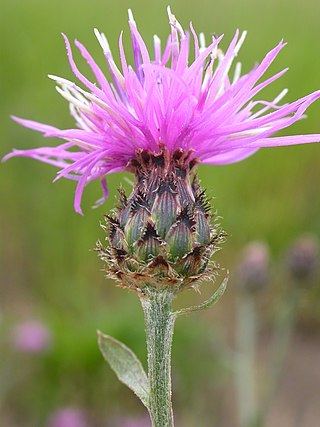
Centaurea stoebe, the spotted knapweed or panicled knapweed, is a species of Centaurea native to eastern Europe, although it has spread to North America, where it is considered an invasive species. It forms a tumbleweed, helping to increase the species' reach, and the seeds are also enabled by a feathery pappus.
Invasive species are a serious threat to the native biodiversity of South America and are an ongoing cost to South American agriculture. South America is an important region for the world's biodiversity, and includes a wide variety of native species, many of which provide medicinal uses. Introduced species in South America, have the potential to pose harm to ecosystems of the region and the aforementioned biodiversity. Although many of these non-native species are invasive, residents of the region often value these species, making it more difficult to organize efforts to get rid of them. Because of the instrumental and cultural value placed on these species, greater awareness, research, and policy are all necessary steps in solving invasive issues in South America. Here is a list of just a few of the species that have invaded South America and where they originate.

Climate change and invasive species refers to the process of the environmental destabilization caused by climate change. This environmental change facilitates the spread of invasive species — species that are not historically found in a certain region, and often bring about a negative impact to that region's native species. This complex relationship is notable because climate change and invasive species are also considered by the USDA to be two of the top four causes of global biodiversity loss.
References
- 1 2 Burgos-Rodríguez, Jhoset; Burgiel, Stanley W. (January 2020). "Federal legal authorities for the early detection of and rapid response to invasive species". Biological Invasions. 22 (1): 129–146. doi: 10.1007/s10530-019-02148-w . ISSN 1387-3547.